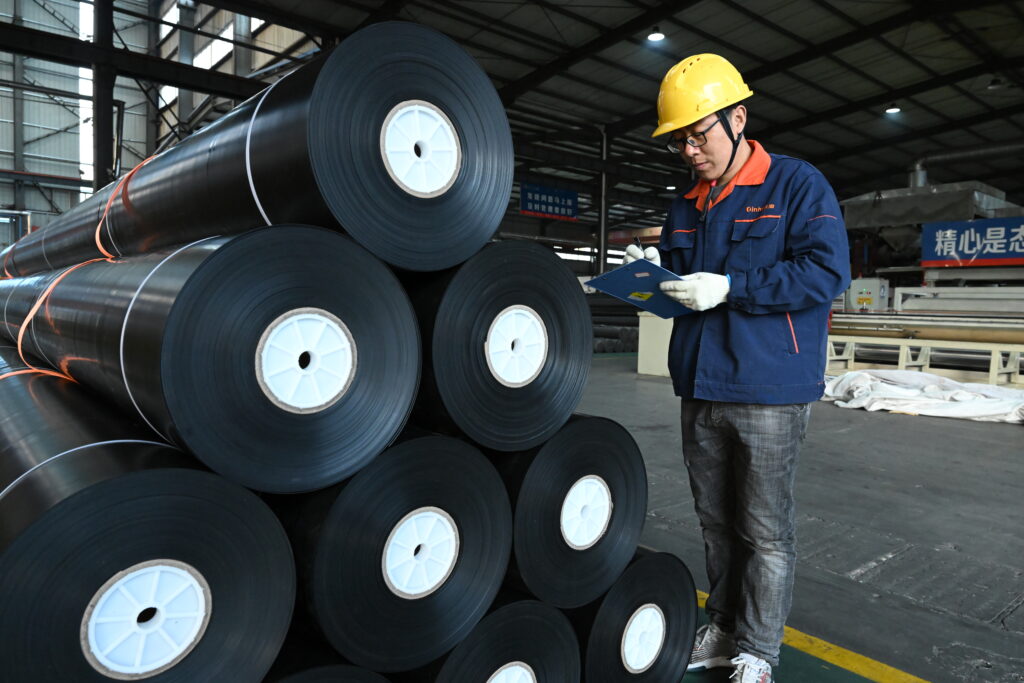How to deal with the edges of geomembrane?
Edge treatment of geomembrane is an important step to ensure waterproofing effect. Here are some common geomembrane edge treatments:
Buried soil treatment: The edges of the geomembrane can be buried underground and covered with a layer of soil or other suitable materials. This protects the edges from UV and mechanical damage and helps maintain membrane stability. The depth of buried soil should usually comply with relevant design requirements.
Weighted materials: A layer of weighted materials, such as sandbags, large rocks or other suitable materials, can be laid near the edge of the geomembrane to prevent wind or other external forces from causing the membrane material to move.
Mechanical fixing: Use mechanical means, such as ground nails, U-shaped nails or other fixing devices, to fix the edges of the geomembrane to the ground or other structures. This helps ensure a tight fit of the membrane and prevents it from blowing or sliding around in the wind.
Adhesives: With some geomembrane materials, specialized adhesives can be used to bond the edges together. This approach requires ensuring that the adhesive chosen is compatible with the geomembrane material and that the manufacturer’s recommendations are followed during construction.
Thermal welding: If the geomembrane used is of the thermal welding type, the edges can be thermally welded using specialized thermal welding equipment to form a sealed seam. This method usually provides better waterproofing results.
Adding edge strips: At the edges of the geomembrane, specially designed edge strips can be added that provide additional protection from edge damage.
Regular Inspections and Maintenance: Perform regular inspections of the edges of the geomembrane and promptly repair any damage or wear found. Regular maintenance can extend the service life of the geomembrane and ensure its waterproof performance.
When performing geomembrane edge treatment, the appropriate method needs to be selected based on the specific project requirements, the characteristics of the geomembrane material, and the manufacturer’s recommendations. Maintaining the integrity and stability of the geomembrane edge is critical to ensuring the waterproofing effect of the entire geomembrane system.

Why does geomembrane need to be installed on the base layer?
There are several key reasons for installing a geomembrane base:
Protection: The base layer acts as a protective layer beneath the geomembrane. It prevents sharp objects such as stones, broken bricks or roots from damaging the geomembrane. If the geomembrane comes into direct contact with these sharp objects, it may cause damage or perforation, weakening its waterproof function.
Flat surface: The base layer can provide a more uniform and flat surface, which is conducive to the laying and fitting of the geomembrane. Uneven or bumpy ground can cause the geomembrane to develop tension on its surface, increasing the risk of wear and damage.
Prevent punctures and pressure dissipation: Installing a geomembrane above the base layer can reduce pressure and puncture risks on the geomembrane surface. The base layer can act as a buffer layer to reduce the impact of external pressure on the geomembrane.
Improve the life of the geomembrane: By installing the base layer, the direct contact between the geomembrane and the ground surface can be reduced, and the mechanical damage and chemical erosion to the geomembrane can be reduced, thereby extending its service life.
Auxiliary drainage and anti-infiltration: In some cases, the base material itself may have auxiliary drainage and anti-infiltration functions, helping to maintain a dry environment beneath the geomembrane.
Therefore, installing a substrate helps ensure that the geomembrane works optimally in terms of waterproofing, protection and functionality. Selecting the appropriate base material and construction method is critical to the long-term performance of the geomembrane system.
Why is geomembrane afraid of UV rays?
The main reason why geomembranes are usually afraid of ultraviolet light (UV light) is that ultraviolet radiation can have an adverse effect on geomembrane materials, leading to aging, embrittlement and degradation of the materials. The following are the effects of UV rays on geomembranes and their causes:
Oxidation and aging: Ultraviolet light in ultraviolet rays can cause oxidation reactions, causing the oxygen atoms in the geomembrane material to combine with carbon, hydrogen, nitrogen and other atoms in the molecules, thereby gradually oxidizing and aging the material. This can cause the geomembrane material to lose flexibility, strength, and surface roughness, ultimately reducing its performance and lifespan.
Embrittlement: UV rays can also cause embrittlement of geomembrane materials. Geomembranes are meant to be flexible so they can conform and be used on different terrains. But UV exposure can make geomembranes brittle and prone to cracking and breakage.
Color Change: Geomembranes may change color when exposed to UV rays, usually becoming lighter. While this does not necessarily affect its functionality, it can provide clues as to how long the geomembrane has been exposed.
Performance degradation: After the waterproof performance and mechanical properties of the geomembrane are affected by ultraviolet rays, they may not meet the design requirements, resulting in a reduction in waterproof function.
To combat the UV sensitivity of geomembranes, the following measures can be taken:
Choose a UV-resistant geomembrane: Some geomembrane manufacturers produce UV-resistant geomembranes that have special additives that mitigate UV damage.
Covering or screening: For installed geomembranes, consider adding a covering or screening to reduce UV exposure.
Regular maintenance: Regularly check the condition of the geomembrane to detect and repair damage caused by ultraviolet rays in a timely manner.
Overall, understanding a geomembrane’s sensitivity to UV rays and taking appropriate protection and maintenance measures are critical to ensuring its long-term performance.

